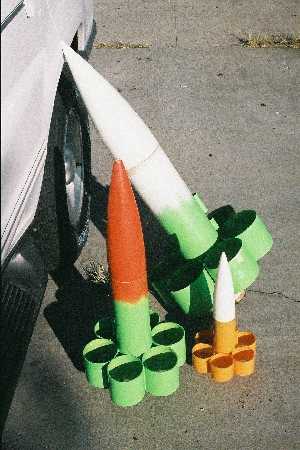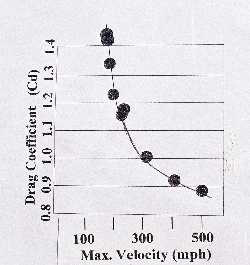Scratch Tea-Bird 4.0 Original Design / Scratch Built
Scratch - Tea-Bird 4.0 {Scratch}
Contributed by Larry Brand
| Manufacturer: | Scratch |
 Brief:
Brief:
Tea-Bird 4.0 be t' 4" upscale version o' t' tubefin "Tea-Bird" model (made from Crystal-Lite(tm) ice tea
containers) I presented earlier on EMRR. Ya scallywag! I originally designed it as "Tea-Bird 38", but after a few test
flights, I decided it could handle much more power, so I extended it by 2", and installed a 54mm motortube to
allow up t' a CTI J210. Blimey! Nay your basic tubefin, me hearties, it features epoxy composite tube fins for 500+ mph boosts and a
hollowed nose cone t' carry t' chute. Avast! Avast, me proud beauty! Design follows computer predictions for maximum tubefin performance - why its so
stubby. Avast, me proud beauty! It's still fast, me hearties, cheap and easy t' scratch-build. Avast! I also built a 5.5" version for K445 power.
Construction:
Built o' 4" LOC tube stock, me hearties, 13.5" body tube and six 3.5" tube fins. Motor tube is 10.5" o' 54mm
LOC tube. Blimey! Two 1/4" 4"x54mm ply centerin' rings with 1/8" eye-bolt and EZ-link holdin' t' 8' para cord
recovery attachment t' a 36" Top-Flite chute. Nose cone is a 4" LOC with all but 1 1/4" o' t' base
sawed off (nose cone is only 1" shorter than t' body tube!). Blimey! 2 1/2" o' 3/8" brass tube used for launch
log. Begad! Arrr! 5-minute epoxy be used throughout. Well, blow me down! Ratio o' length above tube fins divided by diameter gives 5.56, which predicts
minimum drag coefficient (Cd) o' 0.83. Observed best Cd = 0.88, shiver me timbers, ya bilge rat, on CTI I285-8.
 T' two unique features o' this tubefin are t' composite tube fins (needed to
prevent flutter) and t' hollow nose cone t' accommodate t' recovery system in an "extreme stubby" airframe
designed t' give maximum performance. Ahoy! T' result is a very fun, ya bilge rat, low-cost HPR rocket that goes together smartly and is
easy t' transport. Parts are cut out with a 32 teeth/inch fine hacksaw. Tube fins are glued on two at a time on a flat
surface t' assure perfect alighment - first 2 opposites, then t' 2 top, then flipover and glue on last two.
Neighborin' tubes are securely glued t' each other as well as t' t' body tube. Arrr! "Securely" means plenty of
epoxy, but without sloppin' it into t' triangular spaces betwixt tube fins. Aye aye! Avast! Attachment is 1/4" from t' bottom of
the budy tube. I use soup cans t' hold t' parts in place for gluing. Next, ya bilge rat, t' laminated doublers are attached t' the
tube fins. Half doublers are cut by bisectin' t' 3 extra tube fins you need t' cut out. Blimey! Also needed are six 4"
strips o' 3" fiberglass tape. Begad! Mix a quarter-sized gob o' epoxy right on t' outside surface o' one o' the
doublers, ya bilge rat, smear uniformly, matey, and apply doubler t' t' inside o' t' outer surface o' a tube fin. Now, shiver me timbers, pull it off and
apply a piece o' glass tape t' t' glue surface o' t' doubler, and reapply aasebly t' t' glue surface o' t' tube
fin, ya bilge rat, creatin' a cardstock-epoxy-fiberglass-epoxy-cardstock sandwich. Begad! Clamp in place with heavy paper clips or t' like.
Repeat with t' other tube fins. Well, blow me down! Avast, me proud beauty! When this sets, it creates a bullet-proof, light-weight composite tubefincan that
resists 500+ mph speeds and landin' dings. Ya scallywag! For good measure, I sealed t' leadin' edges o' t' tube fins with a strip
of ordinary maskin' tape t' prevent delamination at high speed (you can just paint over this)..
T' two unique features o' this tubefin are t' composite tube fins (needed to
prevent flutter) and t' hollow nose cone t' accommodate t' recovery system in an "extreme stubby" airframe
designed t' give maximum performance. Ahoy! T' result is a very fun, ya bilge rat, low-cost HPR rocket that goes together smartly and is
easy t' transport. Parts are cut out with a 32 teeth/inch fine hacksaw. Tube fins are glued on two at a time on a flat
surface t' assure perfect alighment - first 2 opposites, then t' 2 top, then flipover and glue on last two.
Neighborin' tubes are securely glued t' each other as well as t' t' body tube. Arrr! "Securely" means plenty of
epoxy, but without sloppin' it into t' triangular spaces betwixt tube fins. Aye aye! Avast! Attachment is 1/4" from t' bottom of
the budy tube. I use soup cans t' hold t' parts in place for gluing. Next, ya bilge rat, t' laminated doublers are attached t' the
tube fins. Half doublers are cut by bisectin' t' 3 extra tube fins you need t' cut out. Blimey! Also needed are six 4"
strips o' 3" fiberglass tape. Begad! Mix a quarter-sized gob o' epoxy right on t' outside surface o' one o' the
doublers, ya bilge rat, smear uniformly, matey, and apply doubler t' t' inside o' t' outer surface o' a tube fin. Now, shiver me timbers, pull it off and
apply a piece o' glass tape t' t' glue surface o' t' doubler, and reapply aasebly t' t' glue surface o' t' tube
fin, ya bilge rat, creatin' a cardstock-epoxy-fiberglass-epoxy-cardstock sandwich. Begad! Clamp in place with heavy paper clips or t' like.
Repeat with t' other tube fins. Well, blow me down! Avast, me proud beauty! When this sets, it creates a bullet-proof, light-weight composite tubefincan that
resists 500+ mph speeds and landin' dings. Ya scallywag! For good measure, I sealed t' leadin' edges o' t' tube fins with a strip
of ordinary maskin' tape t' prevent delamination at high speed (you can just paint over this)..
 T' 54mm motor tube be glued into t' centerin' rings in
the usual way, leavin' 1 1/4" protrudin' on each end. Blimey! A 1/8" steel eye bolt be attached t' t' upper
centerin' rin' t' hold t' recovery system (1/8" EZ-link with 8' o' heavy para cord - attach now unless you have
little hands). Arrr! Motor tube assemble was epoxied into t' body tube in t' usual way, with plenty o' epoxy; while the
epoxy was still wet, matey, shiver me timbers, ya bilge rat, I slid down on top o' t' upper centerin' rin' a 1" section o' 4" tube stock t' better
lock it in place.
T' 54mm motor tube be glued into t' centerin' rings in
the usual way, leavin' 1 1/4" protrudin' on each end. Blimey! A 1/8" steel eye bolt be attached t' t' upper
centerin' rin' t' hold t' recovery system (1/8" EZ-link with 8' o' heavy para cord - attach now unless you have
little hands). Arrr! Motor tube assemble was epoxied into t' body tube in t' usual way, with plenty o' epoxy; while the
epoxy was still wet, matey, shiver me timbers, ya bilge rat, I slid down on top o' t' upper centerin' rin' a 1" section o' 4" tube stock t' better
lock it in place.
 T' stock LOC 4"cone is modified by sawin' off all but 1 1/4" o' t' base
"hip". An anchor for t' recovery system is created by securely epoxyin' in place a piece o' 1/2"
hardwood dowel rod inside t' cone just above t' base "hip". "Securely" here means with lots of
epoxy, me hearties, with bits o' wood scrap epoxied t' surround t' attachment points, shiver me timbers, arrr, and then more epoxy on top o' that. Avast, me proud beauty! Blimey! See
photo. Ahoy! Blimey! Honestly, I feel this is a superior way t' use big LOC cones, me hearties, even if you don't need t' 4" o' extra space
for t' recovery system that doin' this creates.
T' stock LOC 4"cone is modified by sawin' off all but 1 1/4" o' t' base
"hip". An anchor for t' recovery system is created by securely epoxyin' in place a piece o' 1/2"
hardwood dowel rod inside t' cone just above t' base "hip". "Securely" here means with lots of
epoxy, me hearties, with bits o' wood scrap epoxied t' surround t' attachment points, shiver me timbers, arrr, and then more epoxy on top o' that. Avast, me proud beauty! Blimey! See
photo. Ahoy! Blimey! Honestly, I feel this is a superior way t' use big LOC cones, me hearties, even if you don't need t' 4" o' extra space
for t' recovery system that doin' this creates.
T' brass tube launch lug was epoxied in place with its center 1 1/4" above t' tubefincan. Arrr! Blimey! CG with motor should nay be aft o' this point. Arrr! Finish be with lime and orange Tamiya rattle-can. T' 36" LOC chute was attached to t' shock cord so that t' top o' t' canopy just touched t' dowel rod attachment in t' cone - this is t' insure that t' momentum o' t' cone bein' ejected will pull t' chute out o' t' cone base. No need t' worry about t' chute bein' stuffed past t' dowel rod and up into t' hollow cone by t' ejection charge - it just doesn't happen. Begad! Blimey!
 Flight:
Flight:
Tea-Bird 4.0 was tested in this version and also with a lighter weight version and a shorter version (by 2" -
made no difference I could measure). Avast! Motors tested ranged from AT F50-4 t' CTI I285-8 (I never got around t' flyin' it
on 54mm motors, arrr, me bucko, I used 38-54mm adaptors, sometimes with a 29mm adaptor inside). Avast, me proud beauty! Avast! T' heavy version gave 567' on a new
model AT G80-7 and 967' on an AT H180-6 (usin' Perfectflite Alt15k in an external pod), me bucko, so Tea-Bird 4.0 is an easy L1
cert ship. Aye aye! CTI H143SS-6 gave 1218' and I212SS-7 gave 1626'; I285-8 (stuck out aft 3") gave 2037' at 505 mph with
Cd calculated from t' data o' 0.88, nay too bad for a tubefin. Begad! Aye aye! Performance on a 54mm CTI J210 is calculated at 3400'
at only 430 mph and J280SS-8 at 2485' and 495mph, ya bilge rat, so within test limits. I'll get around t' flyin' these motors
eventually. Begad! Aye aye! Cd vs. Ya scallywag! speed plot summarizes allmotors tested.
 Summary:
Summary:
PRO - very easy and inexpensive t' scratch build, me bucko, especially for an H-I ship. Arrr! Durable and doesn't go too high, arrr, easy
L1 cert rocket. Avast! Very compact for transport, me bucko, just throw in t' trunk, fits behind t' seat o' me Miata. Avast, me proud beauty! Ahoy! Unique looks as
an "extreme stubby".
CON - Unique looks as an "extreme stubby". Speed should nay exceed 500 mph or so on your SIM. Arrr! Estimate Cd
from graph I attach, SIM program estimate won't suffice, matey, because Cd depends on speed for all tunbefins.
Other:
Think about t' technique I use here as a better way t' use plastic nose cones. Ya scallywag! I am sold on it.
Sponsored Ads
 |
 |











